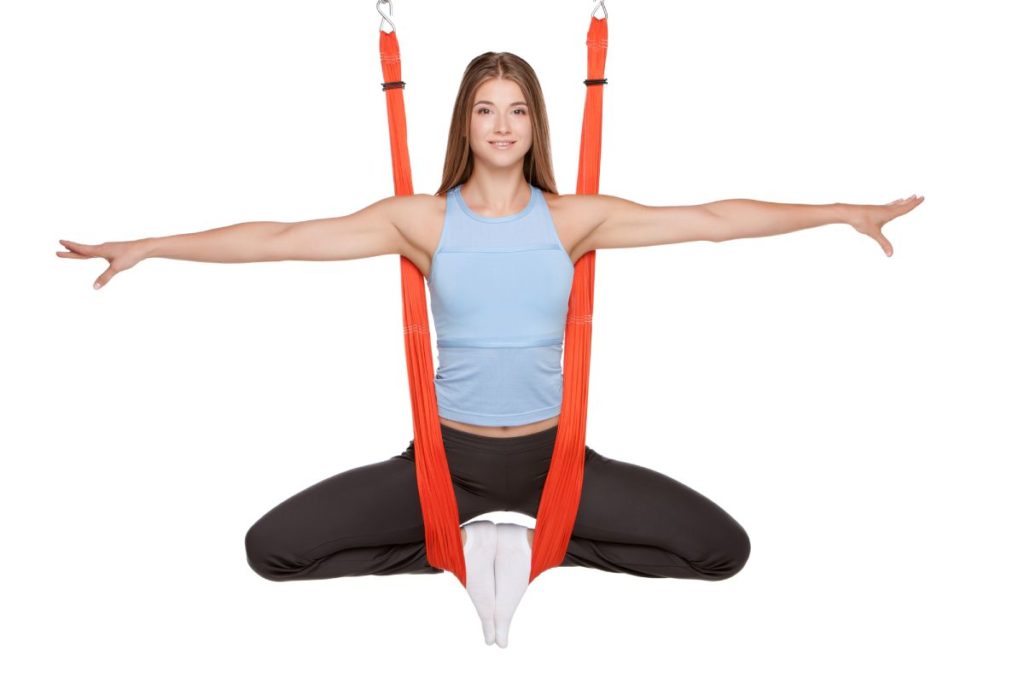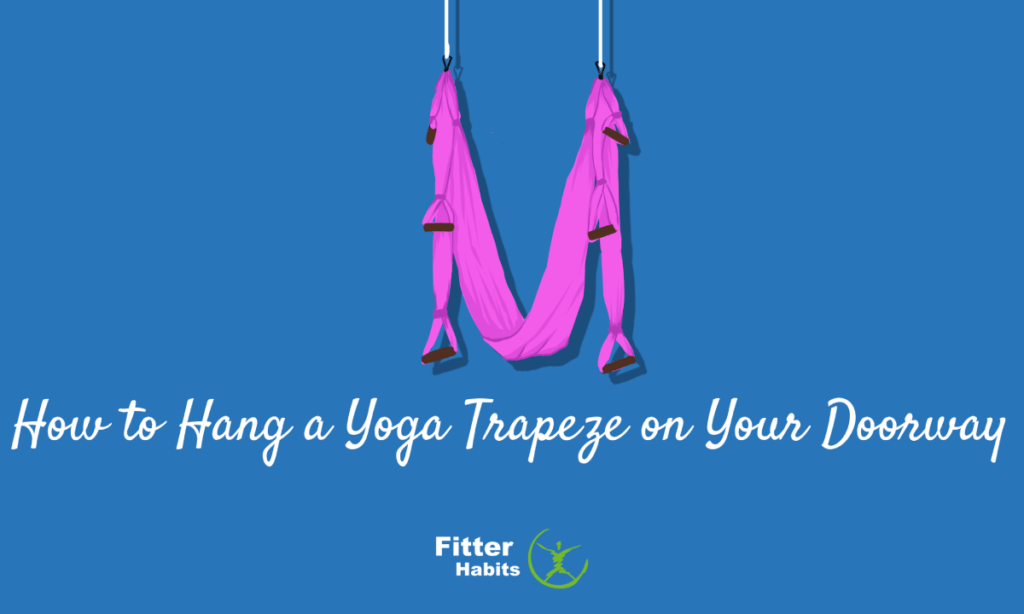If you’re ready to level-up your yoga routine, a yoga trapeze is a great investment, but learning how to hang a yoga trapeze securely is important.
A yoga trapeze is a suspension system that gives you the support you need to try many variations on classic poses. Most of all, it is great for inversions.
You can relieve spinal compression by hanging upside down in your yoga trapeze, but you must install it properly. Install it incorrectly, and you could end up falling on your head.
There are many ways to hang your yoga trapeze, but one good way is in a doorway. This seven-step guide will help you easily hang your trapeze the right way, to reduce your risk of injury. In addition to this guide, please carefully read and follow all instructions that come with your yoga trapeze and any mounting hardware you buy.
Contents
Step 1: Choose A Yoga Trapeze

A yoga trapeze goes by a variety of other names, such as a yoga hammock, yoga swing, or aerial yoga silks. It usually consists of three parts.
In the center is a large swath of parachute-grade fabric that hangs like a hammock, except with the two ends suspended from the ceiling (usually 24-36 inches apart) rather than from two widely-spaced trees or poles. This piece is sometimes known as a yoga sling, yoga swing, or saddle.
Each of the other two pieces of the trapeze is a contraption made of three loops of parachute fabric set at different heights, with padded handles. These sets of handles hang on each side of the hammock-shaped piece. They give you something to hold onto when you are inverting, or you can use them to build upper body strength.
At the top of each end of the hammock piece, and at the top of the handle pieces, there is a metal ring or carabiner that allows you to hang the trapeze.
The fabric may be nylon, taffeta, silk, or cotton. For most yogis, non-stretchy nylon is a good safe, durable, and affordable option.
Make sure to get a trapeze made of high-quality materials. A trapeze made of fabric that is not parachute-grade could tear after some use. Also, the hardware on the trapeze should be made of strong metal rated to hold several times your body weight.
Keep in mind that when you use the yoga trapeze you will be suspending your entire body weight and you will also be moving, which creates force that pulls against the mounting hardware, along with gravity. That can be a lot of force.
Buy your yoga trapeze from a company that has conducted a rigorous quality control inspection and certifies the product to support several times your body weight.
Step 2: Choose Protective Flooring
Even if you buy a high-quality trapeze and mount it correctly, there’s always the possibility of falling from your yoga trapeze. Being a yogi doesn’t guarantee you never have a klutzy moment.
That means you should use some sort of padding on the floor under your trapeze. Preferably you should use something substantially thicker than an ordinary yoga mat.
One great option is interlocking foam floor tiles (like these, available at amazon.com), which can be removed and put away after your yoga session. A heavily padded carpet can also work. Another option is to layer several yoga mats for better protection.
Step 3: Choose A Mounting Option
A yoga trapeze can be hung from mounting hardware attached to strong joists in a ceiling, or from a mounted bar in a doorway.
One option that doesn’t require mounting is a metal frame system (like this option). If you have a room or garage with strong exposed beams, you can avoid mounting hardware by looping a daisy-chain rope around the beam (many yoga trapezes come with daisy-chains, or you can buy them separately, for example this option).
The key is providing a stable mounting point that will ensure your safety. If you have the space, and no exposed beams, the best option is usually to mount from the ceiling, screwing directly into ceiling joists, using heavy-duty ceiling hooks (like this option, which is certified to safely suspend up to 1400 pounds).
This option enables you to hang your trapeze away from walls, where you will have a full range of motion in every direction. It also means that you can hang the trapeze higher than in a doorway system.
However, if you don’t have room in your home to mount from the ceiling, mounting from a doorway can be a great option. The higher the doorway the better, to give you flexibility in how high you want your trapeze to hang.
Step 4: Choose Door Open or Door Closed
There are two different mounting options for installing a yoga trapeze in a doorway, a closed-door option and an open-door option.
The closed-door option has the advantage of being extremely quick and easy to put up and take down, but you will be limited in how you can use your yoga trapeze, because you will be hanging up against the door.
It can also be difficult to find the correct daisy chains (with door stoppers) for this mounting option. If you find the right equipment, this video shows how to install and use a closed-door system.
The much more popular open-door option requires more mounting equipment and more effort to install and uninstall it whenever you want to use it. However, being able to hang in direct vertical alignment in the doorway, and to stretch out your arms and legs in front of or behind you, makes the open-door installation method well worth it.
Step 5: Choose Mounting Bar
To suspend your yoga trapeze in a doorway, you will need a sturdy mounting bar. These are similar to and can be used like a pull-up bar. However, not every pull-up bar is suitable.
Avoid using a “telescopic” bar (which twists open to the width of the doorframe, using spring tension to hold it in place like a shower curtain rod), or one which hangs from the doorframe without attaching securely.
While telescopic bars may be adequate for pull-ups, they are not stable enough for the diverse movement of a yoga trapeze, and they are not trustworthy enough to do inversions from. After all, if the bar falls down during a pull-up you land on your feet or bottom, but if you fall during an inversion you’ll land on your head.
It is crucial to choose a sturdy “mounted” pull-up bar, which bolts into the doorframe, rather than any mounting system without screws. For example, you could consider this option or this one.
Many of mounted bars (such as the two options we mentioned) have detachable bars. That means you can leave the mounting brackets in the doorway but remove the bar when not in use, so that you don’t reduce the height of the doorway.
Step 6: Install Door Mount Bar
Follow the instructions that come with your mounting bar. In general, the process will be something like this.
Hold each mounting plate up to the inside of your doorframe, as close to the top as possible while allowing room to insert and remove the bar, and roughly centered (not on the edge of the doorframe). Using a pencil, make marks in the screw holes in the mounting plate, so you will know where to drill. Make sure they are aligned at the same height and the same distance from each edge of the doorframe.
Put down the mounting plates. Use a power drill to drill holes in the places you marked. Use an appropriately sized drill bit. It should be slightly smaller than the size of your screw threads. If the hole is too large, the screws will pull out of the holes when you put any weight on them.
It is very important that you screw the brackets into the solid beams that make up the doorway, not just the thin wood trim that is visible on the inside of the doorway. If your drill is going through an inch or less of wood, it is not a safe place to hang your trapeze.
Screw the mounting plates into place using provided screws. These should be long, heavy-duty screws that are certified to bear weight equal to a minimum of several times your body weight. When the mounting plates are secure, set the bar in place.
Test the mounting bar. Get a friend to help. Both of you should grab on, lift your feet so the bar is supporting your full weight, and swing around a bit. Make jerky movements.
If the mounting bar feels anything other than rock-solid, do not use it for your yoga trapeze, and find a different location.
Step 7: Hang Yoga Trapeze
Simply clip the carabiners (at the top of the sling and each set of handles) around your chin up bar. If the bar is too large, buy two carabiners large enough to fit around the bar, and then attach your trapeze to those.
Most doorways are short enough that you will not need to use daisy chains to hang your trapeze. If the trapeze is too high for you, wrap the top of the daisy chains around the bar, slide the rest of the chain from that loop to create a secure extension, and then attach the trapeze’s carabiners to the loop at your preferred height.
The Final Word on How to Hang A Yoga Trapeze in A Doorway
With a secure yoga trapeze, you will discover a whole new world of yoga waiting for you. Use the trapeze to provide support for a deep heart opener like Upward Bow Pose. Decompress your spine with an inversion like Arrow Pose.
Strengthen your core with Superman Pose. Find poses online, or experiment and watch how your body responds to the new challenge.
Beyond yoga, you can use your doorway-hung yoga trapeze for other activities. Try using the bar (or the highest handles, for an even bigger challenge) for pullups or a flexed-arm hang. Hold onto the handles and lean back for a variation on a typical set of squats.
Or just curl up in the hammock for a nap. You’ll find that as long as you keep safety in mind, there’s no wrong way to use your yoga swing.



